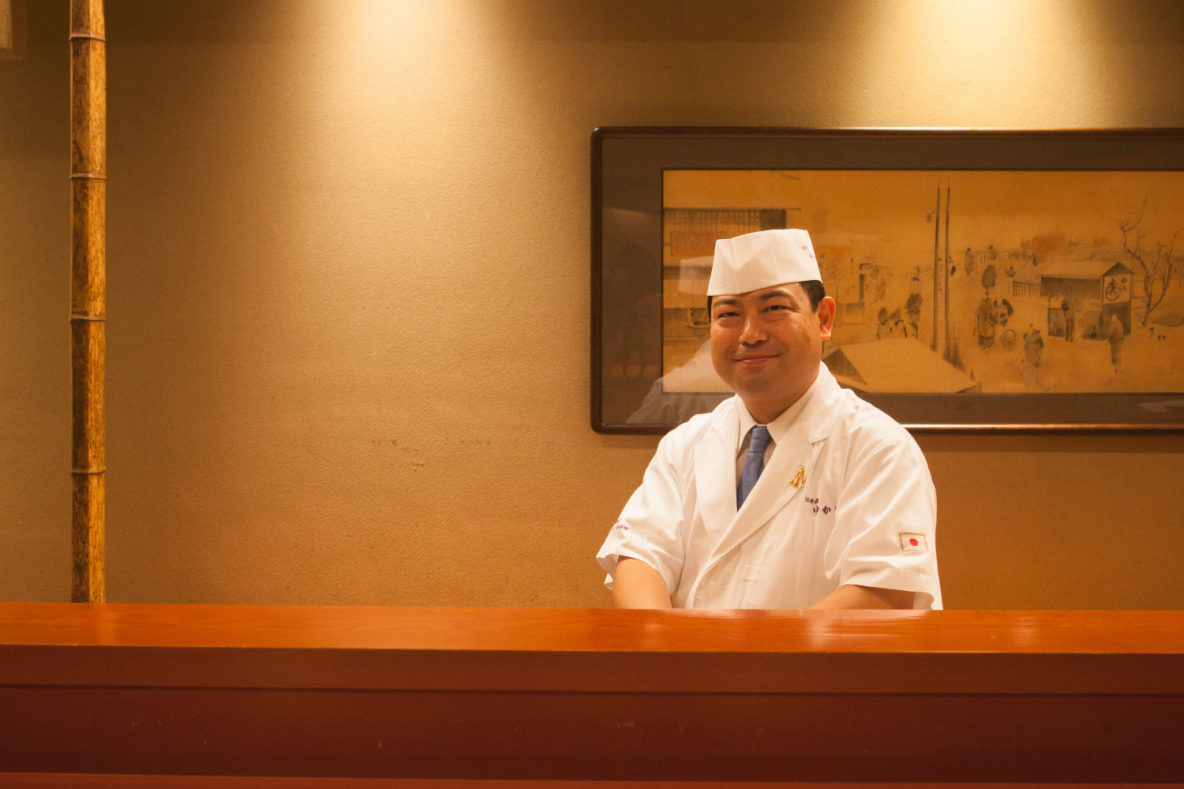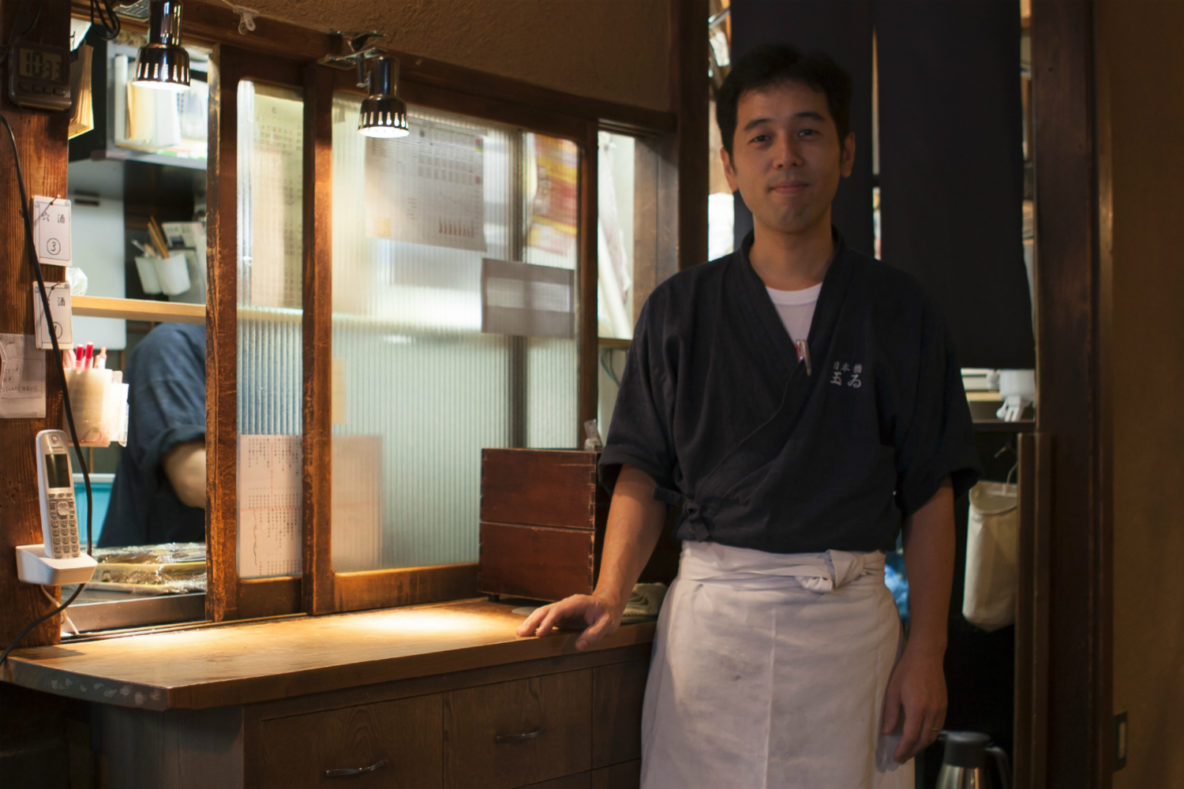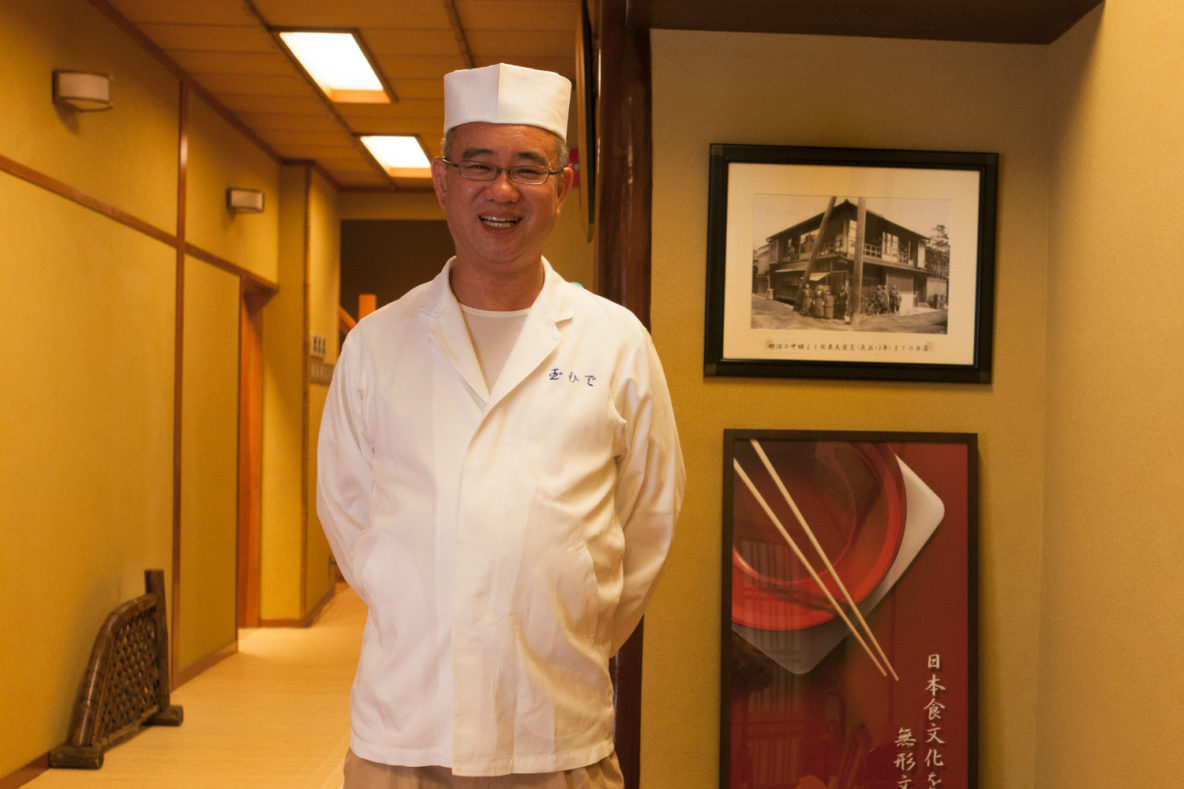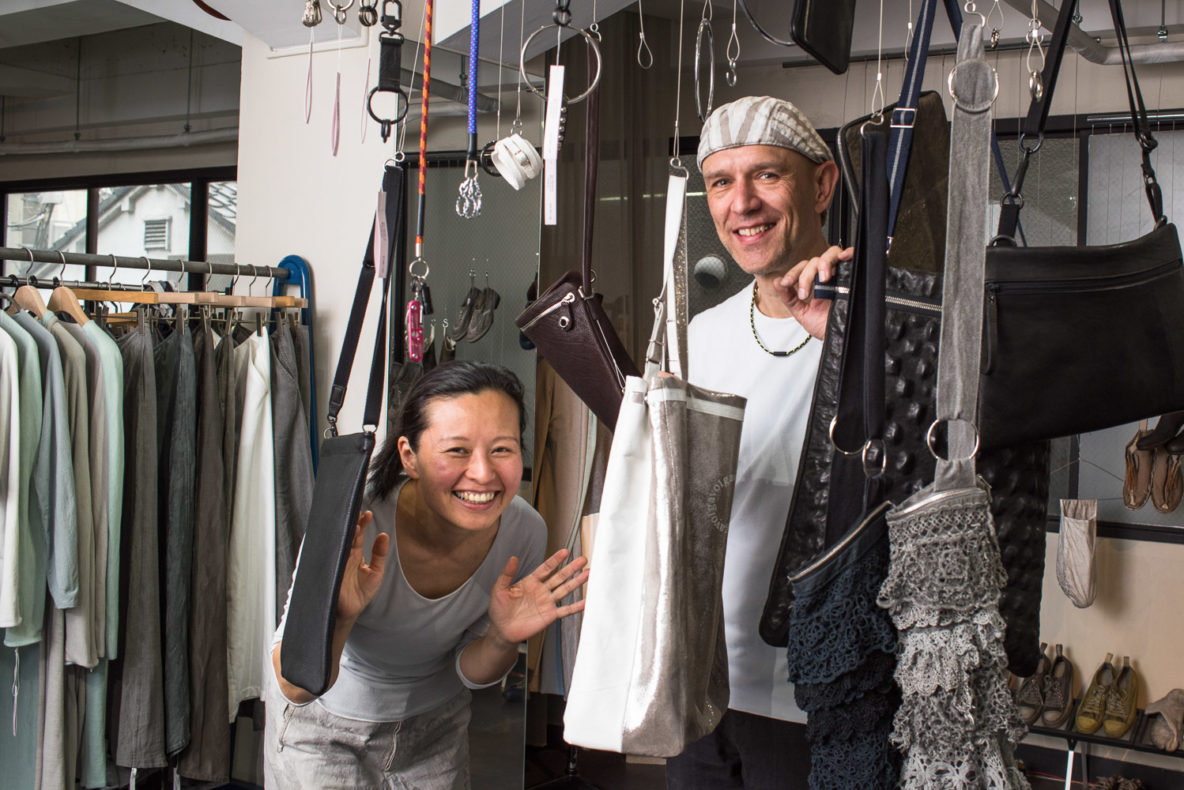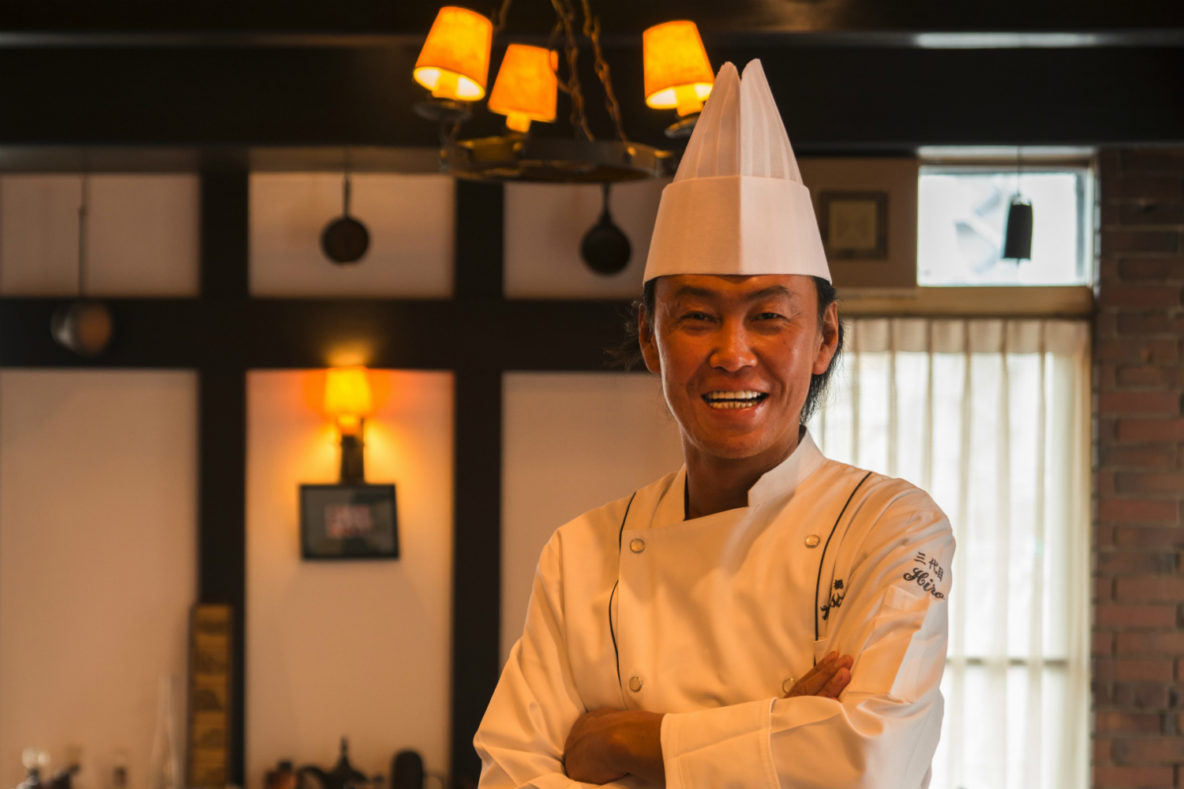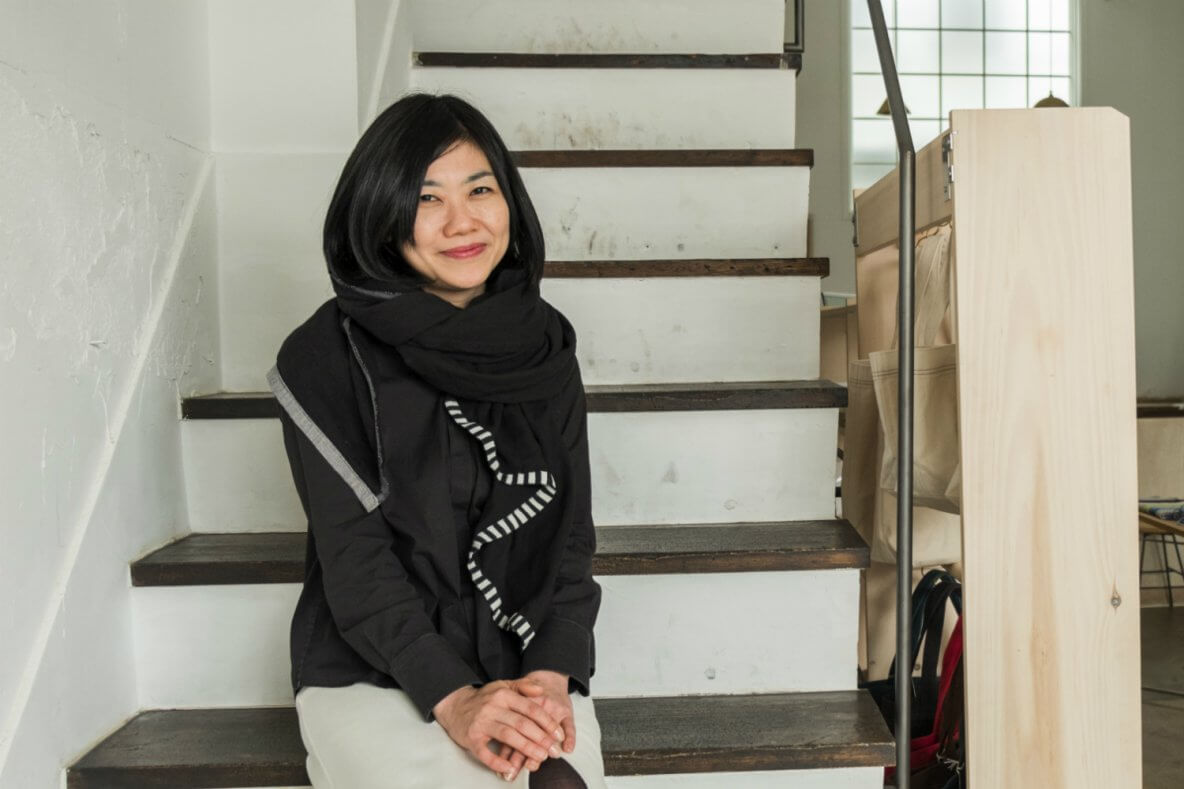Just like wine makers, Japanese chefs value terroir – the sense of place communicated through the ingredients they use and the dishes they make. For Kimio Nonaga of Nihonbashi Yukari, the place he wants to share is the heart of old Tokyo – the place he calls home. Nihonbashi is a mercantile district named after the bridge of the same name. The proverbial centre point of the capital, the bridge and those who travel over it are guarded by statues of dragon-like creatures – winged giraffes, according to folklore – and Nonaga’s restaurant is located just a short walk away. “They have a special meaning to us,” he says. “They tell us to protect our heritage while also flying forwards. In Nihonbashi, we must always be a bridge between the present and the past.” Nonaga is a member of a rare tribe known as edokko, or ‘child of Edo,’ a term reserved only for the most authentic citizens – people whose parents and grandparents were all born and raised in the city now known as Tokyo. His grandfather founded the restaurant in 1935, naming it after his favourite kabuki play, and the young Kimio took the reins from his father at just 24. In the private rooms, waitresses in kimono serve formal kaiseki – fixed menus containing many small, artfully prepared dishes. At the counter, patrons can chat with the chef as he prepares their meals. Like most traditions, kaiseki is governed by strict rules, and like most great chefs, Nonaga knows when to break them. There’s cured prosciutto ham and made-in-Tokyo mozzarella cheese in his kitchen – hardly traditional Japanese ingredients. “The scent, texture and taste of the cheese are just a little bit different from Italian mozzarella, because it comes from our own climate,” he says. “But I guess that’s why it goes so well with my cooking.” The most important rule, however, can never be broken: kaiseki must follow the rhythms of nature – not merely the obvious four seasons, but its 24 micro seasons, fleeting moments during which some ingredients are available for just a few short weeks each year. Baby bamboo shoots take centre stage in early March, but just two weeks later edible cherry leaves are in bloom and appear, salted, on the plate. The valuable matsutake mushrooms prized in early autumn are quickly replaced by glorious orange persimmons – hollowed out and re-stuffed with a mixture of their own fruit and seasoned tofu. Given Nonaga’s breeding, his preference for local produce is no surprise: the seafood comes from nearby waters, the pork from farms on the edge of the city. Some of the vegetables are even grown on the restaurant’s roof, right there in Nihonbashi. “Kaiseki has a clear understanding of ingredient, place and time,” Nonaga explains. “But more than that it’s about hospitality, and it’s about healing. After eating it, you feel well.”
Tamai
“Eating anago makes you smarter,” says chef Yuji Sato, tapping his temple with one finger. “It’s also chock-full of vitamins and minerals. And it even improves your eyesight.” Sato’s admiration for anago – or conger eel – makes sense considering that his restaurant Tamai is, he says, the only remaining specialist in it in Tokyo. The saltwater creatures once thrived in the waters of Tokyo Bay, making them commonly found in the capital’s cuisine, and Sato still sources his eels locally during the summer. By wintertime, however, the water is too cold and they come from southern Japan. “We only use wild eels – never farmed,” says Sato, a frank-talking golf fanatic who spends most weekends playing rounds with his customers. “Supply is our number one concern.” The filleting process for anago is similar to that for the freshwater eel unagi, beginning with a nail through the eel’s head to keep it still. After that, however, anago is simpler to cook, thanks to its thinner skin and leaner flesh. By far the most commonly ordered dish is the hako meshi – a lacquer box filled with a bed of rice that nestles two slithers of anago, one grilled and one boiled, along with a selection of condiments. But Sato encourages adventurous patrons to try other items from the menu too, because in his words: “the sea eel has many different faces.” In winter he recommends tempura, which highlights its sweet, light flesh. August to October, when local anago are in season, is the time for pure, simple sashimi. Sato, who trained as a sushi chef, was born to the east of the city. After taking over Tamai, he fell in love with his new neighbourhood in the heart of old Tokyo. Despite its location behind the famous Takashimaya department store in Nihonbashi, Tamai feels it has managed to slither free of the tightening grip of modernisation. Most other old buildings in this historic quarter have long since been squeezed out by giant steel and concrete offices. But Tamai’s shop – a former liquor store – is all charm, and in a comforting display of neighbourly values, still shares its kitchen with a sake bar around the corner. “Technically this is a business district, but it’s a place without hierarchy,” says Sato. “People still help each other out and ask how you are or where you’ve been.” In a nod to the provenance of the building, the perfect way to end a meal at Tamai is with a cup of warm anagozake, alcohol that (of course) contains a salted, dried and roasted surprise. It pairs perfectly with hone-sembei, the bones of the eel extracted during filleting and then deep fried to make a crunchy calcium-rich snack. “And there you have it,” says Sato, “anago is even good for your body – it strengthens your bones.”
Tamahide
Oyakodon, Japan’s favourite comfort dish, may also be its most appropriately named. ‘Mother and child rice bowl’, as the name literally translates, combines bite-sized chunks of chicken, with eggs cooked lightly in sweet soy sauce until they just begin to set. This is served over a generous bowl of steaming white rice. Tamahide is the storied home of oyakodon. But Kounosuke Yamada, its bespectacled eighth-generation chef, says his family’s restaurant is about more than just one dish. Tamahide is the only restaurant in Tokyo – and one of only a handful in the country – to specialise in Japanese chicken cuisine. The most important ingredient is Shamo, a dark-feathered breed of bird praised for its lean, gamey meat. According to Yamada, Shamo ranks alongside the best breeds of chicken in the world, on a par with French Poulet de Bresse. The restaurant began trading in 1760, processing chicken for noble families in the city then known as Edo. A dish called Shamo nabe (hotpot) was its original specialty: a version of stew-like sukiyaki made with chicken instead of beef, along with noodles, leeks and tofu, all seasoned with soy sauce and honmirin, a syrup made from sweet rice rich with umami. Oyakodon got its start by happenstance during Tamahide’s fifth generation. A thrifty customer was reluctant to waste some leftover chicken. The quick-thinking wife of the chef suggested he throw it into the seasoned sukiyaki pot with a couple of raw eggs. The result was an instant hit. At the time, Japan’s rice-eating culture deemed it unseemly to soil rice by covering it with other food; only the lower classes would do that. For its first 90 years, the dish as we know it today was served only for delivery to merchants in the local Ningyocho area, never on the premises – Tamahide had an image to maintain after all. Over time, however, donburi dishes (bowls of rice with toppings) became popular among other classes, and Tamahide could sell its oyako donburi with pride. Tamahide has already been in business for more than 250 years. Now the ninth-generation chef, Kunio, is preparing to take over from his father in serving the poultry pilgrims who travel here from all over Japan. People eating alone have no choice but to line up and wait for the donburi. But Chef Yamada suggests parties of two or more try the set menu, for which reservations are accepted. This starts with Shamo chicken prepared in two different ways, and ends with the signature oyakodon, presented in a golden lacquered bowl. Eating oyakodon from a bowl resembling a golden egg seems appropriate at Tamahide. And not only because of the restaurant’s shining success. The bowl is also symbolic of the precious bonds this accidental dish has helped to nurture. Parent to child, from generation to generation.
Volga Volga
Long before their lives became intertwined as partners and co-creators, the international couple behind Tokyo-based fashion brand Volga Volga were already enjoying parallel adventures. Shiori Kurushima, from Japan, was in Paris making haute couture for the Japanese designer Hanae Mori; and Mikhail Panteleev, from Russia, was doing similar work in Tokyo for Yohji Yamamoto. If it were destiny that they would meet, however, the appointment would have to wait. “My French friend knew Mikhail and wanted to set us up,” Kurushima says. “But he couldn’t speak my language, and I couldn’t speak his, so it took time for us to come together.” Kurushima and Panteleev were establishing themselves as talented, dedicated fashion designers. In their respective ateliers on opposite sides of the world, they were the ones who would volunteer for extra tasks, often working alone late into the night, cutting patterns or stitching garments. “I wanted to learn everything,” Kurushima recalls of her time working as a ‘premiere main’, a coveted position in charge of hand-sewing entire couture pieces. “The other girls probably thought I was the stereotypical Japanese workaholic.” The brand the couple launched together in 2000 is a union of his designs and her technical skills. In their construction, the garments feel effortless, while in their style they are expressive. From afar, the clean lines and muted colours appear minimalist. But up close, the details and textures evoke a deeper emotion rippling below the surface, like a shout underwater. In Moscow in the 1990s, Panteleev held one of the first-ever fashion shows inside the Kremlin. The spectacle was an impressive way to launch his career, but these days he avoids such productions. “When you’re putting on a show you don’t have time to finish anything properly,” he says. “At this point in our careers, we prefer to give every piece of clothing the attention it deserves.” In Volga Volga’s studio – up a narrow staircase inside an old converted office building in the Bakurocho neighbourhood – sewing tables line one wall, rolls of fabric are stacked at the back, and a show space in the middle is where buyers and walk-in customers can view the collection. In Bakurocho – an area of old Tokyo known colloquially as shitamachi, or the ‘low city’ – they have discovered a sense of kinship with the people, reputed to be unpretentious, hardworking, and loyal. Volga Volga’s shoes often incorporate buttons, ribbons, or buckles made by local artisans with a shared commitment to timeless craftsmanship. “Some of our customers are still using the same garments we made for them 15 years ago,” she says. “When it needs mending, they know they can bring it here, and we’ll give it a another lifespan.” Living together in ‘shitamachi’, Kurushima and Panteleev can follow their own rhythm, commuting to work by bicycle, enjoying a slow lunch at the café next door, and – as has always been their way – working late into the night making beautiful clothes. Only now, the atelier is theirs.
Taimeiken
The line outside Taimeiken forms early on weekends – dozens of patrons waiting patiently for an hour, perhaps two. Ask any one of them what they’re waiting for and their reply will be the same: omuraisu. To the uninitiated, this does not sound like a dish worth waiting for: an omelette (omuretsu) filled with rice (raisu) that’s been fried or seasoned with wine and ketchup, and served with a demi-glace sauce. But slice into it, and a history rich in the idiosyncrasies of modern Japan spills out. Taimeiken specialises in yoshoku, a curious cousin to Japan’s admittedly varied stable of fare. Literally translated, yoshoku means ‘Western food’ – although few Westerners would recognise its dishes as their own. Its lexicon includes kareraisu, or curry rice, which uses a natively-produced curry that Indians and Brits find extremely mild; hambaagu, akin to a hamburger without the bun; and Napolitan – spaghetti cooked with vegetables and dollops of ketchup. The restaurant was founded in 1931 by the late Shingo Modegi, a lover of food and kites (his museum of Japanese kites is on the fifth floor of the same building). Today his grandson Hiroshi is in charge of the family business. Hiroshi’s hobbies – surfing and tanning – reflect a different era. But his commitment to the family business is clear. “When I was a young boy,” he recalls, “I found a letter from my grandfather addressed to ‘The Third Generation of Taimeiken’. I was the eldest son, I knew right then that it was my honour and responsibility to take over the family business.” The restaurant feels intentionally nostalgic, a throwback to a tumultuous era. In the late 1800s, after centuries of self-imposed isolation, Japan reluctantly opened up to the world. The arrival of the American ‘Black Ships’ had demonstrated the military and economic superiority of the West. Japan’s leaders felt small, both figuratively and – as the Americans towered above them – physically. They were desperate to catch up. Members of the elite were dispatched to Europe and North America. They returned with lessons to bolster Japan’s military and economy – and it’s cuisine. They believed that if they ate Western food they would quite literally grow bigger. The dishes they brought home were localised, becoming collectively known as yoshoku. They are eaten not with chopsticks, but with knives, forks and spoons, and served in dining rooms by waiters and waitresses wearing quaint uniforms long since discarded by most Western restaurants. Taimeiken’s menu is a comprehensive collection of yoshoku dishes, including everything from macaroni gratin to beef stew. But its most famous product is its omuraisu, which was featured in the classic Eighties film Tampopo. Other varieties of the dish commonly have the rice contained inside the omelette, but Taimeiken’s ‘Tampopo Omuraisu’ places the egg on top. Eating it involves its own ritual: it is sliced lengthways down the middle of the fat, yellow mound to expose the runny insides, before the demi-glace sauce is poured into its core. “Our sauce … Read More
Kumu
“Connecting people,” says Noriko Konuma, smiling as she sips tea from a white porcelain cup at a naturally-hewn wooden table inside Kumu Tokyo, the intimate design gallery and shop she curates. “It’s all about bringing people together and creating special moments in their daily lives.” In the years since Konuma opened her gallery on a quiet lane in the eastern Bakurocho district in 2015, Kumu (“to connect” in Japanese) has showcased the works of dozens of Japanese creatives, from paper artists and contemporary incense makers to potters and floral designers. She calls them “family”, which makes Kumu their collective home. The small, two-storey structure, renovated by Atelier Etsuko Architects, has a minimal industrial feel, with swathes of original concrete, high ceilings, a warehouse-like window façade and green plants. For Konuma, it’s a very personal space: her family’s businesses previously occupied the building, and she grew up across the street in the same house where her father was born. “The Bakurocho neighbourhood feels different from the rest of Tokyo,” she explains. “There are few big businesses, it’s still very local, and people form friendships naturally.” That openness is attracting a burgeoning creative community, including art galleries and garment makers, ceramics stores and independent cafés. Kumu’s ground floor is home to a shop with a permanent collection of design products – mostly contemporary takes on traditional craftsmanship – and a gallery space hosting up to 15 exhibitions a year. A clean, white upper floor and plant-populated roof terrace host workshops and events. Centre stage in the shop are works by designer Masanori Oji (who also created Kumu’s circular, interwoven logo), from the angular warmth of his metal household fixtures to the clean petal-like lines of his white ceramics. Thick canvas bags by Kurashiki Hanpu and incense handcrafted by Chikako Perez of Tokyo Kodo come encased in ‘washi’ paper by Chiaki Morita – one of several collaborations made possible through Kumu. “It’s not so important that we sell things,” says Konuma, warm, softly spoken and ever-elegant in minimal monochromes. “Of course, sales keep creative techniques alive. But the essential thing is creating new connections, because together these people form the DNA of a Japanese spirit that links the traditional with the future.”
- Page 1 of 2
- 1
- 2

